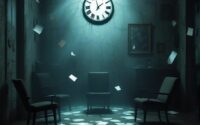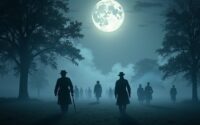The Poltergeist of Enfield: Latest Theories
The Enfield poltergeist case won’t stay buried in the past. New investigations into the 1977 Hodgson family haunting have uncovered fresh perspectives that challenge everything skeptics and believers thought they knew. Modern researchers aren’t just rehashing old arguments—they’re applying cutting-edge psychological theories and forensic analysis to evidence that’s puzzled experts for decades. What they’ve discovered might finally explain why this case refuses to fade away.
Introduction

When unexplained knocking sounds first echoed through a council house in Enfield, North London, in August 1977, nobody could’ve predicted that the events would spawn one of history’s most documented paranormal cases. The Hodgson family’s experiences attracted investigators, journalists, and skeptics worldwide. Over eighteen months, witnesses reported furniture moving independently, objects flying across rooms, and eleven-year-old Janet Hodgson allegedly levitating and speaking in deep, masculine voices. Society for Psychical Research members Maurice Grosse and Guy Lyon Playfair documented over 2,000 paranormal incidents. Police officers, photographers, and BBC reporters witnessed phenomena they couldn’t explain. Today, researchers continue analyzing evidence from the case, proposing new theories ranging from poltergeist activity to psychological manifestations. The Enfield haunting remains Britain’s most controversial supernatural investigation.
977 Hodgson Family Haunting
As single mother Peggy Hodgson struggled to raise four children in their cramped Enfield council house, strange disturbances began disrupting their already difficult lives in late August 1977. Janet, eleven, and Margaret, thirteen, first reported furniture moving on its own. Within days, knocking sounds erupted from walls, toys flew across rooms, and beds shook violently.
The phenomena intensified around Janet specifically. She’d levitate, speak in deep masculine voices, and exhibit impossible physical contortions. Neighbors, police officers, and journalists witnessed objects moving without explanation. The family couldn’t escape—disturbances followed them to relatives’ homes. Over eighteen months, investigators documented over two thousand paranormal incidents. The Hodgsons endured psychological strain, public scrutiny, and accusations of fraud while their home became Britain’s most famous haunted house.
Notable Cases or Sightings

While the Hodgson family’s ordeal captured international attention, several specific incidents during the Enfield haunting became particularly notorious among paranormal researchers. The levitation of Janet Hodgson remains the most controversial event—photographer Graham Morris captured her seemingly floating above her bed in December 1977. Witnesses reported furniture moving independently, including a heavy chest of drawers that slid across Janet’s bedroom while investigators watched.
The poltergeist’s alleged voice manifestations through Janet produced over two hours of recorded material. It claimed to be “Bill Wilkins,” a man who’d died in the house years earlier. Police Constable Carolyn Heeps signed an affidavit confirming she’d seen a chair move unaided. Perhaps most disturbing, investigators documented over 400 incidents of objects flying across rooms, including when toys and household items struck visitors.
Common Theories or Explanations
Despite decades of investigation, researchers haven’t reached consensus on what caused the Enfield phenomena. Skeptics maintain the events were elaborate hoaxes orchestrated by the Hodgson children, particularly Janet, who admitted to faking some incidents. They cite inconsistencies in witness testimonies and the family’s financial struggles as potential motives.
Paranormal researchers propose genuine poltergeist activity triggered by Janet’s adolescent psychokinetic energy. This theory suggests emotional turmoil unconsciously manifested as physical disturbances. Some investigators believe a combination occurred—authentic phenomena amplified by deliberate trickery.
Psychological explanations include mass hysteria, suggestion, and misinterpretation of natural occurrences. Dr. Anita Gregory argued the family sought attention following their father’s departure. Meanwhile, parapsychologists like Maurice Grosse defended the case’s authenticity, documenting unexplained recordings and witness accounts from police officers and neighbors.
Frequently Asked Questions
What Happened to the Hodgson Family Members After the Haunting Ended?
The Hodgson family members moved on with their lives after the haunting. Janet became a care assistant, Margaret pursued a normal life, and their mother Peggy lived quietly until her death in 2003.
Has Anyone Successfully Recreated the Phenomena Under Controlled Laboratory Conditions?
No one’s successfully recreated the Enfield poltergeist phenomena under controlled laboratory conditions. Scientists haven’t been able to duplicate the levitations, furniture movements, or voice phenomena that witnesses reported, leaving the events scientifically unverified.
Which Specific Investigators or Experts Have Recently Changed Their Opinions About the Case?
No major investigators have publicly reversed their positions recently. Maurice Grosse’s recordings remain debated, while Guy Lyon Playfair maintains authenticity. Newer researchers like Ciaran O’Keeffe express skepticism, but veteran investigators haven’t markedly shifted their original assessments.
Are There Any Ongoing Legal Disputes Related to the Enfield Case?
There aren’t any known ongoing legal disputes directly related to the Enfield Poltergeist case. The Hodgson family hasn’t pursued litigation, and no current lawsuits involve the original witnesses, investigators, or media companies who’ve covered the events.
What Equipment or Methods Do Modern Paranormal Investigators Recommend for Similar Cases?
Modern paranormal investigators recommend using EMF detectors, infrared cameras, digital voice recorders, motion sensors, and environmental monitoring devices. They’ve adopted scientific protocols including baseline readings, controlled experiments, and multiple witness documentation for credible evidence collection.


